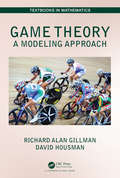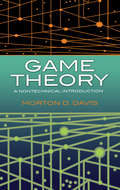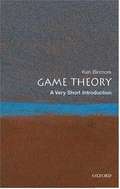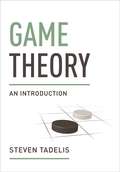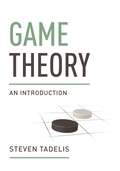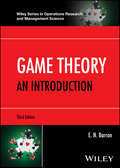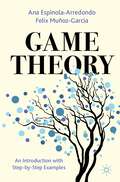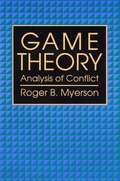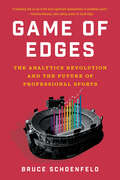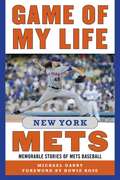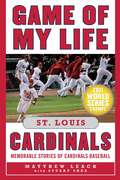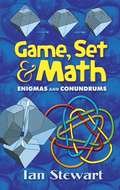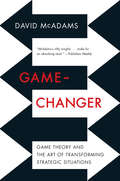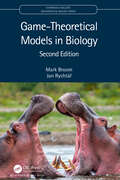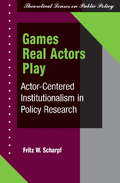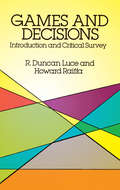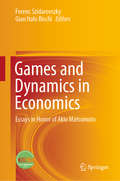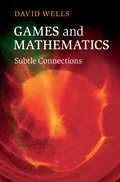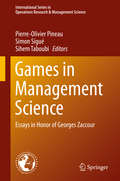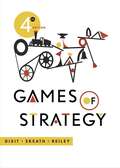- Table View
- List View
Game Theory: A Modeling Approach (Textbooks in Mathematics)
by Richard Alan Gillman David HousmanGame Theory: A Modeling Approach quickly moves readers through the fundamental ideas of the subject to enable them to engage in creative modeling projects based on game theoretic concepts. The authors match conclusions to real-world scenarios and applications. The text engages students in active learning, group work, in-class discussions and interactive simulations. Each chapter provides foundation pieces or adds more features to help readers build game theoretic models. The chapters include definitions, concepts and illustrative examples. The text will engage and challenge both undergraduate and graduate students. Features: Enables readers to apply game theorty to real-world scenarios Chapters can be used for core course materials or independent stuides Exercises, included at the end of the chapters, follow the order of the sections in the text Select answers and solutions are found at the end of the book Solutions manual for instructors is available from the authors
Game Theory: A Nontechnical Introduction
by Morton D. Davis"A lucid and penetrating development of game theory that will appeal to the intuition . . . a most valuable contribution." -- Douglas R. Hofstadter, author of Gödel, Escher, BachThe foundations of game theory were laid by John von Neumann, who in 1928 proved the basic minimax theorem, and with the 1944 publication of the Theory of Games and Economic Behavior, the field was established. Since then, game theory has become an enormously important discipline because of its novel mathematical properties and its many applications to social, economic, and political problems.Game theory has been used to make investment decisions, pick jurors, commit tanks to battle, allocate business expenses equitably -- even to measure a senator's power, among many other uses. In this revised edition of his highly regarded work, Morton Davis begins with an overview of game theory, then discusses the two-person zero-sum game with equilibrium points; the general, two-person zero-sum game; utility theory; the two-person, non-zero-sum game; and the n-person game.A number of problems are posed at the start of each chapter and readers are given a chance to solve them before moving on. (Unlike most mathematical problems, many problems in game theory are easily understood by the lay reader.) At the end of the chapter, where solutions are discussed, readers can compare their "common sense" solutions with those of the author. Brimming with applications to an enormous variety of everyday situations, this book offers readers a fascinating, accessible introduction to one of the most fruitful and interesting intellectual systems of our time.
Game Theory: A Very Short Introduction
by Ken BinmoreGames are everywhere: Drivers maneuvering in heavy traffic are playing a driving game. Bargain hunters bidding on eBay are playing an auctioning game. A firm negotiating next year's wage is playing a bargaining game. When opposing candidates in an election are playing a political game. The supermarket's price for corn flakes is decided by playing an economic game. Game theory is about how to play such games in a rational way. Even when the players have not thought everything out in advance, game theory often works for the same reason that mindless animals sometimes end up behaving very cleverly: evolutionary forces eliminate irrational play because it is unfit. Game theory has seen spectacular successes in evolutionary biology and economics, and is beginning to revolutionize other disciplines from psychology to political science. This Very Short Introduction introduces the fascinating world of game theory, showing how it can be understood without mathematical equations, and revealing that everything from how to play poker optimally to the sex ratio among bees can be understood by anyone willing to think seriously about the problem.
Game Theory: An Introduction
by Steven TadelisThis comprehensive textbook introduces readers to the principal ideas and applications of game theory, in a style that combines rigor with accessibility. Steven Tadelis begins with a concise description of rational decision making, and goes on to discuss strategic and extensive form games with complete information, Bayesian games, and extensive form games with imperfect information. He covers a host of topics, including multistage and repeated games, bargaining theory, auctions, rent-seeking games, mechanism design, signaling games, reputation building, and information transmission games. Unlike other books on game theory, this one begins with the idea of rationality and explores its implications for multiperson decision problems through concepts like dominated strategies and rationalizability. Only then does it present the subject of Nash equilibrium and its derivatives. Game Theory is the ideal textbook for advanced undergraduate and beginning graduate students. Throughout, concepts and methods are explained using real-world examples backed by precise analytic material. The book features many important applications to economics and political science, as well as numerous exercises that focus on how to formalize informal situations and then analyze them.
Game Theory: An Introduction
by Steven TadelisThe definitive introduction to game theoryThis comprehensive textbook introduces readers to the principal ideas and applications of game theory, in a style that combines rigor with accessibility. Steven Tadelis begins with a concise description of rational decision making, and goes on to discuss strategic and extensive form games with complete information, Bayesian games, and extensive form games with imperfect information. He covers a host of topics, including multistage and repeated games, bargaining theory, auctions, rent-seeking games, mechanism design, signaling games, reputation building, and information transmission games. Unlike other books on game theory, this one begins with the idea of rationality and explores its implications for multiperson decision problems through concepts like dominated strategies and rationalizability. Only then does it present the subject of Nash equilibrium and its derivatives.Game Theory is the ideal textbook for advanced undergraduate and beginning graduate students. Throughout, concepts and methods are explained using real-world examples backed by precise analytic material. The book features many important applications to economics and political science, as well as numerous exercises that focus on how to formalize informal situations and then analyze them.Introduces the core ideas and applications of game theoryCovers static and dynamic games, with complete and incomplete informationFeatures a variety of examples, applications, and exercisesTopics include repeated games, bargaining, auctions, signaling, reputation, and information transmissionIdeal for advanced undergraduate and beginning graduate studentsComplete solutions available to teachers and selected solutions available to students
Game Theory: An Introduction (Wiley Series in Operations Research and Management Science #1)
by E. N. BarronAuthoritative and quantitative approach to modern game theory with applications from areas including economics, political science, computer science, and engineering Game Theory acknowledges the role of mathematics in making logical and advantageous decisions in adversarial situations and provides a balanced treatment of the subject that is both conceptual and applied. This newly updated and revised Third Edition streamlines the text to introduce readers to the basic theories behind games in a less technical but still mathematically rigorous way, with many new real-world examples from various fields of study, including economics, political science, military science, finance, biological science, and general game playing. The text introduces topics like repeated games, Bayesian equilibria, signaling games, bargaining games, evolutionary stable strategies, extensive games, and network and congestion games, which will be of interest across a wide range of disciplines. Separate sections in each chapter illustrate the use of Mathematica and Gambit software to create, analyze, and implement effective decision-making models. A companion website contains the related Mathematica and Gambit data sets and code. Solutions, hints, and methods used to solve most problems to enable self-learning are in an Appendix. Game Theory includes detailed information on: The von Neumann Minimax Theorem and methods for solving any 2-person zero sum matrix game. Two-person nonzero sum games solved for a Nash Equilibrium using nonlinear programming software or a calculus method. Nash Equilibria and Correlated Equilibria. Repeated games and punishment strategies to enforce cooperation Games in Extensive Form for solving Bayesian and perfect information games using Gambit. N-Person nonzero sum games, games with a continuum of strategies and many models in economics applications, duels, auctions, of Nash Equilibria, and the Stable Matching problem Coalitions and characteristic functions of cooperative games, an exact nucleolus for three-player games, bargaining Game theory in evolutionary processes and population games A trusted and proven guide for students of mathematics, engineering, and economics, the Third Edition of Game Theory is also an excellent resource for researchers and practitioners in economics, finance, engineering, operations research, statistics, and computer science.
Game Theory: An Introduction with Step-by-Step Examples
by Felix Muñoz-Garcia Ana Espinola-ArredondoAn introduction to game theory, complete with step-by-step tools and detailed examples. This book offers condensed breakdowns of game-theory concepts. Specifically, this textbook provides “tools” or “recipes” to solve different classes of games. Game Theory presents the information as plainly and clearly as possible. Every chapter begins with the main definitions and concepts before diving into the applications to different settings across economics, business, and other social sciences. Chapters walk readers through algebraic steps and simplifications. This makes the text accessible for undergraduate and Masters-level students in economics and finance. Paired with the exercises published on the accompanying website, students will improve both their theoretical and practical understandings of game theory. Readers will walk away from this book understanding complete and incomplete information models as well as signaling games.
Game Theory: Analysis of Conflict
by Roger B. MyersonEminently suited to classroom use as well as individual study, Roger Myerson's introductory text provides a clear and thorough examination of the models, solution concepts, results, and methodological principles of noncooperative and cooperative game theory. Myerson introduces, clarifies, and synthesizes the extraordinary advances made in the subject over the past fifteen years, presents an overview of decision theory, and comprehensively reviews the development of the fundamental models: games in extensive form and strategic form, and Bayesian games with incomplete information.
Game of Edges: The Analytics Revolution And The Future Of Professional Sports
by Bruce Schoenfeld“A sweeping look at one of the most significant developments in worldwide sports.” —Christine Brennan, best-selling author of Inside Edge The story of how a new generation of tech-savvy franchise owners is reshaping every aspect of professional sports. In the last two decades, innovation, data analysis, and technology have driven a tectonic shift in the sports business. Game of Edges is the story of how sports franchises evolved, on and off the field, from raggedly run small businesses into some of the most systematically productive companies around. In today’s game, everyone from the owners to the marketing staff are using information—data—to give their team an edge. For analysts, an edge is their currency. Figuring out that bunting hurts your offense? That’s an edge. So is discovering metrics that can predict the career arc of your free agent shooting guard. Or combing through a decade of ticket-buying data to target persuadable fans. These small, incremental steps move a sports franchise from merely ordinary to the leading edge. Franchises today are more than just sports; they integrate a whole suite of other businesses—television and digital content, gambling and real estate, fashion and apparel, entertainment, catering and concessions, and much more. But an optimized franchise has no room for error. Teams must do what the numbers say, reducing the element of chance, limiting those random moments of athletic heroism that make sports thrilling to watch. Optimization also means the franchise’s main goal isn’t championships anymore; it’s keeping you, the viewer, engaged with the product. Drawing on extensive interviews with franchise owners, general managers, executives, and players, Bruce Schoenfeld introduces dynamic leaders who are radically reimagining the operations of these decades-old teams—and producing mind-boggling valuations. He joins the architects of the Golden State Warriors dynasty for an exclusive reception before tip-off. He stands among the faithful at Anfield, watching Liverpool’s analytics guru size up a prized midfielder. And he watches the president of the Chicago Cubs break ground on a new DraftKings gambling parlor at Wrigley Field, not ten miles from the site of the original Black Sox betting scandal. Essential reading for anyone interested in sports, business, or technology, Game of Edges explores a world where winning the game is only the beginning.
Game of My Life New York Mets: Memorable Stories of Mets Baseball (Game Of My Life Ser.)
by Michael Garry Howie RoseGame of My Life New York Mets, now newly updated, takes a personal look inside the biggest moments of the Mets’ greatest and most beloved players, from journeymen to superstars. Their most unforgettable games paint a picture of Mets history, as the franchise morphed from a dismal (though lovable) expansion team in 1962 to World Series Champions in 1969 and 1986 and then back to basement dwellers before meeting the Yankees in the 2000 Subway Series, and the Royals in a surprise appearance in the 2015 World Series. Fan favorite Ron Swoboda recounts making “The Catch.” Infielder Wally Backman relives the many thrills of playing on the ’86 Mets as they marched to a championship. All-Star Edgardo Alfonzo describes going six-for-six, including three home runs, in one of the most dominating offensive games in baseball history. Right-hander Bobby Jones recalls pitching the most dominating postseason game in Mets history, when he threw a one-hit shutout to clinch the 2000 National League Division Series against the San Francisco Giants. Current ace Jacob deGrom recounts his gritty series-clinching performance against the Dodgers in Game Five of the NLDS. Journalist Michael Garry, a lifelong Mets fan, also includes stories about Tom Seaver, Mike Piazza, and David Wright, among others.
Game of My Life St. Louis Cardinals: Memorable Stories of Cardinals Baseball (Game of My Life)
by Stuart Shea Matthew LeachDating back to the Gas House Gang of the 1930s and up to the club’s most recent World Championship in 2006, being a Cardinal has meant a style of play, a level of dedication, and a pride in being a member of a special group. This newly updated edition of Game of My Life St. Louis Cardinals exhibits not always the best game of someone’s career, but rather, the moment that stands out the most.
Game, Set and Math: Enigmas and Conundrums
by Ian StewartTwelve essays take a playful approach to the subject, exploring how to play poker over the telephone without the possibility of cheating, how to distinguish plausible fallacies from unbelievable facts, and how to cope mathematically with contorted worms, drunken tennis players, and snakes that eat their own tails.Former columnist for Scientific American's "Mathematical Games" section, Ian Stewart is a professor at the University of Warwick and the author of Another Fine Math You've Got Me Into... and a score of other books of mathematical recreations, popular science, and science fiction. In this collection of pun-studded fables, he once again exercises his immense talent for transforming complicated concepts of modern mathematics into stimulating, accessible fun. Stewart introduces the different kinds of infinity, explains how to build your own virus, explores the brighter ideas of Pascal and Fermat, and even offers a dozen different puzzles for the twelve days of Christmas.
Game-Changer: Game Theory and the Art of Transforming Strategic Situations
by David McadamsA radically new, and easily learned, way to outstrategize your rivals. "The wise win before they fight, while the ignorant fight to win." So wrote Zhuge Liang, the great Chinese military strategist. He was referring to battlefield tactics, but the same can be said about any strategic situation. Even seemingly certain defeat can be turned into victory--whether in battle, business, or life--by those with the strategic vision to recognize how to "change the game" to their own advantage. The aim of David McAdams's Game-Changer is nothing less than to empower you with this wisdom--not just to win in every strategic situation (or "game") you face but to change those games and the ecosystems in which they reside to transform your life and our lives together for the better. Game-Changer develops six basic ways to change games--commitment, regulation, cartelization, retaliation, trust, and relationships--enlivened by countless colorful characters and unforgettable examples from the worlds of business, medicine, finance, military history, crime, sports, and more. The book then digs into several real-world strategic challenges, such as how to keep prices low on the Internet, how to restore the public's lost trust in for-charity telemarketers, and even how to save mankind from looming and seemingly unstoppable drug-resistant disease. In each case, McAdams uses the game-theory approach developed in the book to identify the strategic crux of the problem and then leverages that "game-awareness" to brainstorm ways to change the game to solve or at least mitigate the underlying problem. So get ready for a fascinating journey. You'll emerge a deeper strategic thinker, poised to change and win all the games you play. In doing so, you can also make the world a better place. "Just one Game-Changer [is] enough to seed and transform an entire organization into a more productive, happier, and altogether better place," McAdams writes. Just imagine what we can do together.
Game-Theoretical Models in Biology (Chapman & Hall/CRC Mathematical Biology Series #48)
by Jan Rychtář Mark BroomCovering the major topics of evolutionary game theory, Game-Theoretical Models in Biology, Second Edition presents both abstract and practical mathematical models of real biological situations. It discusses the static aspects of game theory in a mathematically rigorous way that is appealing to mathematicians. In addition, the authors explore many applications of game theory to biology, making the text useful to biologists as well. The book describes a wide range of topics in evolutionary games, including matrix games, replicator dynamics, the hawk-dove game, and the prisoner’s dilemma. It covers the evolutionarily stable strategy, a key concept in biological games, and offers in-depth details of the mathematical models. Most chapters illustrate how to use Python to solve various games. Important biological phenomena, such as the sex ratio of so many species being close to a half, the evolution of cooperative behaviour, and the existence of adornments (for example, the peacock’s tail), have been explained using ideas underpinned by game theoretical modelling. Suitable for readers studying and working at the interface of mathematics and the life sciences, this book shows how evolutionary game theory is used in the modelling of these diverse biological phenomena. In this thoroughly revised new edition, the authors have added three new chapters on the evolution of structured populations, biological signalling games, and a topical new chapter on evolutionary models of cancer. There are also new sections on games with time constraints that convert simple games to potentially complex nonlinear ones; new models on extortion strategies for the Iterated Prisoner’s Dilemma and on social dilemmas; and on evolutionary models of vaccination, a timely section given the current Covid pandemic. Features Presents a wide range of biological applications of game theory. Suitable for researchers and professionals in mathematical biology and the life sciences, and as a text for postgraduate courses in mathematical biology. Provides numerous examples, exercises, and Python code.
Gamer Theory
by Mckenzie WarkListen to a short interview with McKenzie WarkHost: Chris Gondek | Producer: Heron & Crane Ever get the feeling that life's a game with changing rules and no clear sides, one you are compelled to play yet cannot win? Welcome to gamespace. Gamespace is where and how we live today. It is everywhere and nowhere: the main chance, the best shot, the big leagues, the only game in town. In a world thus configured, McKenzie Wark contends, digital computer games are the emergent cultural form of the times. Where others argue obsessively over violence in games, Wark approaches them as a utopian version of the world in which we actually live. Playing against the machine on a game console, we enjoy the only truly level playing field--where we get ahead on our strengths or not at all. Gamer Theory uncovers the significance of games in the gap between the near-perfection of actual games and the highly imperfect gamespace of everyday life in the rat race of free-market society. The book depicts a world becoming an inescapable series of less and less perfect games. This world gives rise to a new persona. In place of the subject or citizen stands the gamer. As all previous such personae had their breviaries and manuals, Gamer Theory seeks to offer guidance for thinking within this new character. Neither a strategy guide nor a cheat sheet for improving one's score or skills, the book is instead a primer in thinking about a world made over as a gamespace, recast as an imperfect copy of the game.
Games Real Actors Play
by Fritz W ScharpfGames Real Actors Play provides a persuasive argument for the use of basic concepts of game theory in understanding public policy conflicts. Fritz Scharpf criticizes public choice theory as too narrow in its examination of actor motives and discursive democracy as too blind to the institutional incentives of political parties. With the nonspecialist in mind, the author presents a coherent actor-centered model of institutional rational choice that integrates a wide variety of theoretical contributions, such as game theory, negotiation theory, transaction cost economics, international relations, and democratic theory. Games Real Actors Play offers a framework for linking positive theory to the normative issues that necessarily arise in policy research and employs many cross-national examples, including a comparative use of game theory to understand the differing reactions of Great Britain, Sweden, Austria, and the Federal Republic of Germany to the economic stagflation of the 1970s.
Games and Decisions: Introduction and Critical Survey (Dover Books on Mathematics)
by Howard Raiffa R. Duncan LuceThis book represents the earliest clear, detailed, precise exposition of the central ideas and results of game theory and related decision-making models — unencumbered by technical mathematical details. It offers a comprehensive, time-tested conceptual introduction, with a social science orientation, to a complex of ideas related to game theory including decision theory, modern utility theory, the theory of statistical decisions, and the theory of social welfare functions. The first three chapters provide a general introduction to the theory of games including utility theory. Chapter 4 treats two-person, zero-sum games. Chapters 5 and 6 treat two-person, nonzero-sum games and concepts developed in an attempt to meet some of the deficiencies in the von Neumann-Morgenstern theory. Chapters 7–12 treat n-person games beginning with the von Neumann-Morgenstern theory and reaching into many newer developments. The last two chapters, 13 and 14, discuss individual and group decision making. Eight helpful appendixes present proofs of the famous minimax theorem, several geometric interpretations of two-person zero-sum games, solution procedures, infinite games, sequential compounding of games, and linear programming. Thought-provoking and clearly expressed, Games and Decisions: Introduction and Critical Survey is designed for the non-mathematician and requires no advanced mathematical training. It will be welcomed by economists concerned with economic theory, political scientists and sociologists dealing with conflict of interest, experimental psychologists studying decision making, management scientists, philosophers, statisticians, and a wide range of other decision-makers. It will likewise be indispensable for students in courses in the mathematical theory of games and linear programming.
Games and Dynamics in Economics: Essays in Honor of Akio Matsumoto
by Ferenc Szidarovszky Gian Italo BischiThis book focuses on the latest advances in nonlinear dynamic modeling in economics and finance, mainly—but not solely—based on the description of strategic interaction by using concepts and methods from dynamic and evolutionary game theory. The respective chapters cover a range of theoretical issues and examples concerning how the qualitative theory of dynamical systems is used to analyze the local and global bifurcations that characterize complex behaviors observed in social systems where heterogeneous and boundedly rational economic agents interact. Nonlinear dynamical systems, represented by difference and differential and functional equations, are extensively used to simulate the behavior of time-evolving economic systems, also in the presence of time lags, discontinuities, and hysteresis phenomena. In addition, some theoretical issues and particular applications are discussed, as well. The contributions gathered here offer an up-to-date review of the latest research in this rapidly developing research area.
Games and Mathematics
by David WellsThe appeal of games and puzzles is timeless and universal. In this unique book, David Wells explores the fascinating connections between games and mathematics, proving that mathematics is not just about tedious calculation but imagination, insight and intuition. The first part of the book introduces games, puzzles and mathematical recreations, including knight tours on a chessboard. The second part explains how thinking about playing games can mirror the thinking of a mathematician, using scientific investigation, tactics and strategy, and sharp observation. Finally the author considers game-like features found in a wide range of human behaviours, illuminating the role of mathematics and helping to explain why it exists at all. This thought-provoking book is perfect for anyone with a thirst for mathematics and its hidden beauty; a good high school grounding in mathematics is all the background that is required, and the puzzles and games will suit pupils from 14 years.
Games and Mathematics
by David WellsThe appeal of games and puzzles is timeless and universal. In this unique book, David Wells explores the fascinating connections between games and mathematics, proving that mathematics is not just about tedious calculation but imagination, insight and intuition. The first part of the book introduces games, puzzles and mathematical recreations, including knight tours on a chessboard. The second part explains how thinking about playing games can mirror the thinking of a mathematician, using scientific investigation, tactics and strategy, and sharp observation. Finally the author considers game-like features found in a wide range of human behaviours, illuminating the role of mathematics and helping to explain why it exists at all. This thought-provoking book is perfect for anyone with a thirst for mathematics and its hidden beauty; a good high school grounding in mathematics is all the background that is required, and the puzzles and games will suit pupils from 14 years.
Games for Math
by Peggy KayeAt a time when the poor math performance of American school children has labeled us a "nation of underachievers," what can parents--often themselves daunted by the mysteries of mathematics--do to help their children? In Games for Math, Peggy Kaye--teacher extraordinaire and author of the highly praised Games for Reading--gives parents more than fifty marvelous and effective ways to help their children learn math by doing just what kids love best: playing games.From the Trade Paperback edition.
Games for Your Mind: The History and Future of Logic Puzzles
by Jason RosenhouseA lively and engaging look at logic puzzles and their role in recreation, mathematics, and philosophyLogic puzzles were first introduced to the public by Lewis Carroll in the late nineteenth century and have been popular ever since. Games like Sudoku and Mastermind are fun and engrossing recreational activities, but they also share deep foundations in mathematical logic and are worthy of serious intellectual inquiry. Games for Your Mind explores the history and future of logic puzzles while enabling you to test your skill against a variety of puzzles yourself.In this informative and entertaining book, Jason Rosenhouse begins by introducing readers to logic and logic puzzles and goes on to reveal the rich history of these puzzles. He shows how Carroll's puzzles presented Aristotelian logic as a game for children, yet also informed his scholarly work on logic. He reveals how another pioneer of logic puzzles, Raymond Smullyan, drew on classic puzzles about liars and truthtellers to illustrate Kurt Gödel's theorems and illuminate profound questions in mathematical logic. Rosenhouse then presents a new vision for the future of logic puzzles based on nonclassical logic, which is used today in computer science and automated reasoning to manipulate large and sometimes contradictory sets of data.Featuring a wealth of sample puzzles ranging from simple to extremely challenging, this lively and engaging book brings together many of the most ingenious puzzles ever devised, including the "Hardest Logic Puzzle Ever," metapuzzles, paradoxes, and the logic puzzles in detective stories.
Games in Economic Development
by Bruce WydickGames in Economic Development examines the roots of poverty and prosperity through the lens of elementary game theory, illustrating how patterns of human interaction can lead to vicious cycles of poverty as well as virtuous cycles of prosperity. The book shows how both social norms and carefully designed institutions can help shape the "rules of the game," making better outcomes in a game possible for everyone involved. The book is entertaining to read, intended for a broad audience, and can be accessed with little background in development economics or game theory. Its chapters explore games in natural resource use; education; coping with risk; borrowing and lending; technology adoption; governance and corruption; civil conflict; international trade; and the importance of networks, religion, and identity, illustrating concepts with numerous anecdotes from recent world events. An appendix explaining basic ideas in game theory used in the book is provided for interested readers.
Games in Management Science: Essays in Honor of Georges Zaccour (International Series in Operations Research & Management Science #280)
by Pierre-Olivier Pineau Simon Sigué Sihem TaboubiThis book covers a large spectrum of cutting-edge game theory applications in management science in which Professor Georges Zaccour has made significant contributions. The book consists of 21 chapters and highlights the latest treatments of game theory in various areas, including marketing, supply chains, energy and environmental management, and cyber defense. With this book, former Ph.D. students and successful research collaborators of Professor Zaccour wish to honor his many scientific achievements.
Games of Strategy
by Avinash K. Dixit Susan Skeath David H. ReileyGames of Strategy, famous for its simple yet accurate exposition and its great examples and exercises, has been extensively revised for this Fourth Edition. The key to its broad success is that the authors assume no prior knowledge of game theory and present the material in the most accessible way possible. With new and improved features and compelling end-of-chapter exercises, this Fourth Edition of Games of Strategy continues to engage students around the world.
